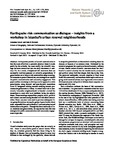Earthquake risk communication as dialogue-insights from a workshop in Istanbul's urban renewal neighbourhoods
| dc.contributor.author | Ickert, J | en |
| dc.contributor.author | Stewart, IS | en |
| dc.date.accessioned | 2016-07-26T15:56:42Z | |
| dc.date.available | 2016-07-26T15:56:42Z | |
| dc.date.issued | 2016-05-23 | en |
| dc.identifier.issn | 1561-8633 | en |
| dc.identifier.uri | http://hdl.handle.net/10026.1/5115 | |
| dc.description.abstract |
An important paradox of hazard communication is that the more effectively a potential physical threat is made public by the scientist, the more readily the scientific message becomes normalized into the daily discourses of ordinary life. As a result, a heightened risk awareness does not necessarily motivate personal or collective preparedness. If geoscientists are to help at-risk communities adopt meaningful measures to protect themselves, new strategies are needed for public communication and community engagement. This paper outlines an attempt to develop a novel approach to train geoscientists, using doctoral and post-doctoral researchers in an EU integrated training network studying tectonic processes and geohazards in Turkey. An urban field visit to seismically vulnerable neighbourhoods in Istanbul allowed the researchers to meet with local residents facing the seismic threat. Those meetings exposed the complex social, political and cultural concerns among Istanbul's at-risk urban communities. These concerns were used to provoke subsequent focus group discussions among the group of geoscientists about roles, responsibilities and methods of communicating hazard information to the public. Through the direct testimony of local residents and geoscientists, we explore the form that new strategies for public communication and community engagement might take. | en |
| dc.format.extent | 1157 - 1173 | en |
| dc.language.iso | en | en |
| dc.title | Earthquake risk communication as dialogue-insights from a workshop in Istanbul's urban renewal neighbourhoods | en |
| dc.type | Journal Article | |
| plymouth.issue | 5 | en |
| plymouth.volume | 16 | en |
| plymouth.publication-status | Published | en |
| plymouth.journal | Natural Hazards and Earth System Sciences | en |
| dc.identifier.doi | 10.5194/nhess-16-1157-2016 | en |
| plymouth.organisational-group | /Plymouth | |
| plymouth.organisational-group | /Plymouth/Faculty of Science and Engineering | |
| plymouth.organisational-group | /Plymouth/Research Groups | |
| plymouth.organisational-group | /Plymouth/Research Groups/Marine Institute | |
| plymouth.organisational-group | /Plymouth/Users by role | |
| plymouth.organisational-group | /Plymouth/Users by role/Researchers in ResearchFish submission | |
| dc.identifier.eissn | 1684-9981 | en |
| dc.rights.embargoperiod | Not known | en |
| rioxxterms.versionofrecord | 10.5194/nhess-16-1157-2016 | en |
| rioxxterms.licenseref.uri | http://www.rioxx.net/licenses/all-rights-reserved | en |
| rioxxterms.type | Journal Article/Review | en |


